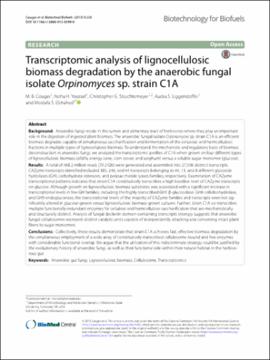| dc.contributor.author | Couger, M. B. | |
| dc.contributor.author | Youssef, Noha H. | |
| dc.contributor.author | Struchtemeyer, Christopher G. | |
| dc.contributor.author | Liggenstoffer, Audra S. | |
| dc.contributor.author | Elshahed, Mostafa S. | |
| dc.date.accessioned | 2018-11-09T21:10:42Z | |
| dc.date.available | 2018-11-09T21:10:42Z | |
| dc.date.issued | 2015-12-08 | |
| dc.identifier | oksd_elshahed_transcriptomica_2015 | |
| dc.identifier.citation | Couger, M. B., Youssef, N. H., Struchtemeyer, C. G., Liggenstoffer, A. S., & Elshahed, M. S. (2015). Transcriptomic analysis of lignocellulosic biomass degradation by the anaerobic fungal isolate Orpinomyces sp. strain C1A. Biotechnology for Biofuels, 8, Article 208. https://doi.org/10.1186/s13068-015-0390-0 | |
| dc.identifier.uri | https://hdl.handle.net/11244/302044 | |
| dc.description.abstract | Background: Anaerobic fungi reside in the rumen and alimentary tract of herbivores where they play an important role in the digestion of ingested plant biomass. The anaerobic fungal isolate Orpinomyces sp. strain C1A is an efficient biomass degrader, capable of simultaneous saccharification and fermentation of the cellulosic and hemicellulosic fractions in multiple types of lignocellulosic biomass. To understand the mechanistic and regulatory basis of biomass deconstruction in anaerobic fungi, we analyzed the transcriptomic profiles of C1A when grown on four different types of lignocellulosic biomass (alfalfa, energy cane, corn stover, and sorghum) versus a soluble sugar monomer (glucose). | |
| dc.description.abstract | Results: A total of 468.2 million reads (70.2 Gb) were generated and assembled into 27,506 distinct transcripts. CAZyme transcripts identified included 385, 246, and 44 transcripts belonging to 44, 13, and 8 different glycoside hydrolases (GH), carbohydrate esterases, and polysaccharide lyases families, respectively. Examination of CAZyme transcriptional patterns indicates that strain C1A constitutively transcribes a high baseline level of CAZyme transcripts on glucose. Although growth on lignocellulosic biomass substrates was associated with a significant increase in transcriptional levels in few GH families, including the highly transcribed GH1 B-glucosidase, GH6 cellobiohydrolase, and GH9 endoglucanase, the transcriptional levels of the majority of CAZyme families and transcripts were not significantly altered in glucose-grown versus lignocellulosic biomass-grown cultures. Further, strain C1A co-transcribes multiple functionally redundant enzymes for cellulose and hemicellulose saccharification that are mechanistically and structurally distinct. Analysis of fungal dockerin domain-containing transcripts strongly suggests that anaerobic fungal cellulosomes represent distinct catalytic units capable of independently attacking and converting intact plant fibers to sugar monomers. | |
| dc.description.abstract | Conclusions: Collectively, these results demonstrate that strain C1A achieves fast, effective biomass degradation by the simultaneous employment of a wide array of constitutively-transcribed cellulosome-bound and free enzymes with considerable functional overlap. We argue that the utilization of this indiscriminate strategy could be justified by the evolutionary history of anaerobic fungi, as well as their functional role within their natural habitat in the herbivorous gut. | |
| dc.format | application/pdf | |
| dc.language | en_US | |
| dc.publisher | BioMed Central | |
| dc.rights | This material has been previously published. In the Oklahoma State University Library's institutional repository this version is made available through the open access principles and the terms of agreement/consent between the author(s) and the publisher. The permission policy on the use, reproduction or distribution of the material falls under fair use for educational, scholarship, and research purposes. Contact Digital Resources and Discovery Services at lib-dls@okstate.edu or 405-744-9161 for further information. | |
| dc.title | Transcriptomic analysis of lignocellulosic biomass degradation by the anaerobic fungal isolate Orpinomyces sp. strain C1A | |
| osu.filename | oksd_elshahed_transcriptomica_2015.pdf | |
| dc.description.peerreview | Peer reviewed | |
| dc.identifier.doi | 10.1186/s13068-015-0390-0 | |
| dc.description.department | Microbiology and Molecular Genetics | |
| dc.type.genre | Article | |
| dc.type.material | Text | |
| dc.subject.keywords | anaerobic gut fungi | |
| dc.subject.keywords | lignocellulosic biomass | |
| dc.subject.keywords | cellulosome | |
| dc.subject.keywords | transcriptomics | |
